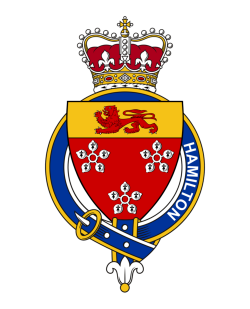
Clan Hamilton
THROUGH
Clan Hamilton are a lowland clan who can trace their heritage back to the 13th century. After Walter Fitz-Gilbert of Hambledon received lands from Robert the Bruce, clan Hamilton increased in important within the country and became heirs presumptive to the Scottish throne through marriage. The current Duke of Hamilton lives in East Lothian.
The Hamilton clan motto is "Through" and the clan crest is a sawn oak tree.
The Tartans
of Clan Hamilton
Scottish History
of Clan Hamilton
“For true service and great manhood”
“For true service and great manhood in slaying the General Lieutenant of England upon Kinneil Muir, King Robert gave all the lands of Kinneil to Sir Gilbert Hamilton.” Thus according to the monk, Friar Mark, in the earliest written history of the House of Hamilton did the family acquire the estate high above the Forth from which the ruins of the Palace of Kinneil still command magnificent views across the river to the shores of Fife and the Ochil Hills beyond.
At the same time that Sir Gilbert received Kinneil, his religious biographer, Friar Mark, also notes that the grateful King Robert the Bruce granted the Hamiltons their coat of arms of “three cinqufois on a bloody ground”.
While The Bruce had good reason to be grateful to Hamilton because in addition to his brave exploits on Kinneil Muir, he was also one of the seven Scottish knights who formed the Royal bodyguard at the Battle of Bannockburn in 1314, another version of how the Hamiltons gained their lands insists that they were actually not granted until 1323 and then not to Gilbert but to his son Walter, who had defended Bothwell Castle for the English and not switched allegiance to the Scottish side until after its fall.
No matter, however, how the Hamiltons came by Kinneil in the midst of the ever changing swirl of Scottish political manoeuverings of the 14th century, they do appear to have been definitely in royal favour by the time of the Bruce’s death in 1329. For it was Hamilton senior who was chosen to give the oration at the burial of the King’s body in Dunfermline Abbey.
To strengthen their hold on their lands of Kinneil, midway between Bo’ness and Grangemouth, the Hamiltons soon built a tall, thick, stone-walled peel tower high above the rocky ravine of the Gil Burn where it crashes down the hillside to join the River Forth. This was an excellent defensive site and parts of the ancient fortification with its narrow arrow-slit windows and gun-ports still dominate the scene above the burn.
At around the same time, the Hamiltons also were awarded lands in Lanarkshire where they built Castle Cadzow just to the south of Hamilton, the town which grew up nearby and bears the family name. The next of the family to play a prominent part in Scottish affairs of state was James Cadzow who became the first Lord Hamilton in 1445.
Linked through marriage to the Douglas family, the new Lord Hamilton supported them against King James II when royal troops besieged their castle at Abercorn, between Bo’ness and Queensferry, in 1455. Despite mustering a strong force of men, they were unsuccessful in raising the royal siege. A few months later King James also succeeded in capturing the other Douglas stronghold, Inveravon Castle, three miles to the west of the Hamiltons’ seat at Kinneil.
Before Kinneil incurred equal royal disfavour, the Hamiltons switched sides and in October of the same year received a special charter from the king, guaranteeing their future rights to all of their lands both at Kinneil and Hamilton.
Lord James also extended his lands in novel fashion. He pioneered land reclamation in Scotland by building a dam across Kinneil Bay and slowly winning valuable acres across from the River Forth. It took seven years to rid the new fields of salt, but by the 1470s they were fit to be farmed and in 1474, the year of his second marriage to Princess Mary, sister of King James III, his new brother-in-law saw fit to confirm the rights to the new lands to the happy pair. In turn they granted the rents from them to support a new church and hospital which they built on the high ground roughly midway between Kinneil and Hamilton at Shotts in Lanarkshire.
Lord Hamilton’s second wife, Mary Stewart, was formerly married to the Earl of Arran and when his young son James succeeded him in 1479, that title was subsequently conferred upon him at a ceremony at Holyrood Palace when he visited Edinburgh in 1503 to attend the wedding of his cousin King James IV to the 14-year-old English Princess Margaret at the marriage of The Thistle and The Rose as it became romantically entitled. It was stated that the lands and Earldom of Arran were bestowed upon him in recognition of, “his nearness of blood, his services and specially for his labours and expenses at the time of the royal marriage”.
The second Lord James, Earl of Arran, had the reputation of being the best archer on foot or on horse in the whole of Scotland and kept a famous stud of horses at Kinneil where King James IV paid a royal visit to the stables in 1508.
With Scotland linked with England through the Marriage of The Thistle and The Rose, it seemed that the country could look forward to a period of peace and so the Hamiltons abandoned living in the draughty old peel tower at Kinneil, which they had required for safety in the more turbulent, strife-torn times, in favour of the greater comforts of a new modern L shaped mansion which they built on an adjacent site. The peace, however, was short lived because James IV in support of his old allies the French soon went to war with his English in-laws and in 1513 paid the price when he and all his young Scottish nobles, the famous Flowers of the Forest, were slaughtered on Flodden’s bloody field.
The King was succeeded by his infant son James V, and Hamilton, Earl of Arran, found himself at the centre of the resultant turmoil when he was appointed Regent of Scotland and had to fight off the rival Douglas claim for supremacy over the young monarch.
Just as with the royal family, when Hamilton died in 1529 he was succeeded by his son while he was still a minor. The boy was placed under the guardianship of his uncle and under his guidance began the construction of Hamilton Palace.
Bid for the Throne
It was indeed fitting that young Hamilton, second Earl of Arran, had a palace as his home because he was a very important young gentleman. Indeed as great grandson of King James II, following the death of James V after the Battle of Solway Moss in 1542, he was no less than heir presumptive to the Scottish throne. As such he was appointed regent to the little week-old Mary, Queen of Scots, when she came to the throne in December of that year.
While she was a babe in arms, the campaign to use the infant Mary to strengthen Scottish links with other countries began.
To begin with Hamilton backed the English bid and in the following year, 1543, signed the Treaty of Greenwich which promised that when of age Mary would marry the then six-year-old Edward, Prince of Wales, thus repeating the process started forty years earlier by the Marriage of The Thistle and The Rose.
This did not meet the wishes of the young Queen’s mother, Mary of Guise or of her chief adviser Cardinal Beaton, who both wanted an alliance with Catholic France.
Within a year Hamilton was persuaded to change his mind and to renege on the Treaty of Greenwich, thus causing Edward’s father Henry III to engage in the famous ‘Rough Wooing’ invasion of the Scottish Borders.
Instead, Regent Hamilton now fell in line with the Queen Mother and the Cardinal to marry Mary to the Dauphin, Francis, Crown Prince of France.
It is suggested that perhaps Hamilton’s change of mind was influenced by questions which were being asked about his father’s second marriage of which he was a product and thus his own legitimacy and that, as the Roman Catholic Church was the deciding factor in such cases, he had to ensure its support.
In any case, Hamilton was richly rewarded for his change of support, because Mary of Guise ensured that he was granted the French Dukedom of Chateauherault.
Five years later, in 1554, Hamilton threw in his lot further with the Queen Mother by agreeing to surrender his position as Regent in her favour, in return for her promise that if Mary, Queen of Scots should fail to produce a child, then he should become King of Scotland.
Hamilton’s hopes of possibly becoming the Scottish monarch suffered a severe setback in 1558 when, following her marriage to Francis, Mary agreed that he also should become King of Scots.
His chances rose again soon afterwards when the Protestant Lords of the Congregation approached them in secret to become their candidate for the throne if they succeeded in deposing the Catholic Queen. The one problem for Hamilton was that his heir was at the time held prisoner in France where he had been leader of the Scots Guard, but as soon as young James escaped, he agreed to champion the Protestant cause.
Then in 1560 events overtook Hamilton yet again when the unexpected and very untimely death of the Dauphin resulted in the widowed Mary’s return to Scotland. Hamilton decided that the best hope of securing the Scottish throne for his family was to propose that his heir James would be the ideal second husband for the Queen.
Instead, Mary announced her betrothal to her cousin Henry, Lord Darnley. Furious at the threat which this match posed to the Hamiltons becoming the future royal family, the Duke, as he was popularly known in Scotland on account of his French title, raised an armed uprising against the Queen.
Despite support for the Earl of Moray, he was defeated and forced to seek refuge in France, where he resided in great style at Chateauherault, until after Mary’s third marriage to Lord Bothwell and her subsequently being deposed from the Scottish throne.
Sadly by this time Hamilton’s heir James, Third Earl of Arran, who had always been a somewhat erratic young man, had now become completely mad, so Hamilton again changed sides and decided to return to Scotland to support the Queen’s cause during her exile in England. This did much damage to his family’s cause and in 1569 Hamilton himself was even imprisoned by his former ally, the Earl of Moray. Three years later in 1572 the by then elderly Hamilton gave in and was persuaded by the English to sign the Pacification of Perth which recognised Mary Queen of Scots’ son James as her successor.
Thus ended the Hamilton’s hopes as the country’s premier noble family of wresting the Scottish throne from the royal house of Stewart.
Family History Mini Book
We hope you enjoyed reading this excerpt from this mini book on the Scottish history of the Hamilton family.
You can buy the full book for only121 Clan Hamilton
Tartan Products
The Crests
of Clan Hamilton














































































